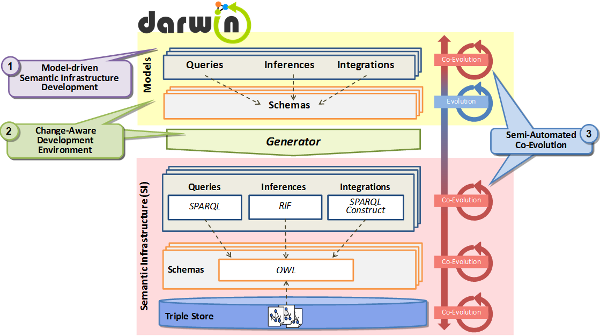About Darwin
Problem
Widespread Adoption of Semantic Infrastructures: In the past few years, developers of ontology-driven applications, being it in the area of the Semantic Web or in traditional applications, increasingly recognized the benefits of adopting semantic infrastructures which commonly comprise ontologies, inference rules, queries, and integration mechanisms. By taking advantage of technologies with well-defined semantics, semantic infrastructures facilitate enhanced searching and reasoning capabilities. Considering the domain of Web applications for example, these benefits lead to a wide adoption resulting in an estimated number of over 2 billions of RDF triples which were publically accessible in 2009. Moreover, semantic infrastructures also found their way into various traditional applications in several domains such as health care, eGovernment, broadcasting.
Deficiencies in Semantic Infrasturcture Development and Evolution: Although the benefits of building ontology-driven applications are widely recognized, the development and evolution of SIs suffers from three crucial deficiencies:
- Inadequate Abstraction Mechanisms. The development of Semantic Infrastructures is currently performed in a highly technology-driven manner by directly adopting languages such as RDF, OWL2, SPARQL3, and RIF4. Hardly any means exist to raise the level of abstraction by, for instance, using conceptual modeling languages.
- Change-Agnostic Development Editors. Most editors used for building Semantic Infrastructures work under the assumption that an application is only a set of editable artifacts neglecting the importance to capture the developer’s intention behind changes, a system undergoes during its evolution. Consequently, developers and tools are not sufficiently equipped to grasp and handle the complexity of steadily changed artifacts.
- Limited Co-Evolution Support. The maintenance of the different highly interdependent artifacts of SIs in terms of achieving global consistency while evolving the schema is a time-consuming and error-prone task. Current development environments for building Semantic Infrastructures miss to adequately support the user in keeping all schema-dependent artifacts in tune when the schema evolves.
Goal of Darwin
The main goal of DARWIN is to provide an extensible framework based on well-established conceptual modeling languages and model-driven engineering techniques enabling developers to entirely develop and evolve semantic infrastructures at an appropriate level of abstraction.
To accomplish this goal, a prototype will be developed, following the conceptual architecture as illustrated in this figure.

Along this overall reserach focus, Darwin pursues three key research goals involving several research challenges:
- Model-Driven Semantic Infrastructure Development: To ease the development of semantic infrastrucutres, the first goal of Darwin is to provide a development toolkit supporting a tailored assembly of model-driven techniques to enable an entirely model-based development process and the automatic generation of semantic infrastructures.
- Change-aware Development Environment: Successful software is always subject to modification. By this goal, we turn changes applied during development into first-class entitities to enable co-evolution of interdependent artifacts as well as the incremental generation of artifacts building the semantic infrastructures.
- Semi-automated Co-Evolution: Every time schemas evolve, dependent artifacts have to be kept in a consistent state. Manually performing this task is often cumbersome and error-prone. To support the user in maintaining the semantic infrastructure, this goals deals with the co-evolution of schema-dependent artifacts such as instances, queries, inferences, and integrations in the model layer.
Approach
The main goal of Darwin is to provide an extensible framework for model-driven development and evolution of semantic infrastructures. According to the three key research goals the proposed architecture of Darwin consists of
- A Semantic Infrastrucutre Development Toolkit for modeling and generating semantic infrastructures,
- A Change Management Framework for providing change summaries for incrementally maintaining semantic infrastructures, and
- A Co-Evolution Framework for co-evolving artifacts when schemas evolve.
